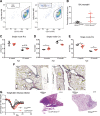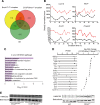Genome-wide effect of pulmonary airway epithelial cell-specific Bmal1 deletion
- PMID: 30794439
- PMCID: PMC6463917
- DOI: 10.1096/fj.201801682R
Genome-wide effect of pulmonary airway epithelial cell-specific Bmal1 deletion
Abstract
Pulmonary airway epithelial cells (AECs) form a critical interface between host and environment. We investigated the role of the circadian clock using mice bearing targeted deletion of the circadian gene brain and muscle ARNT-like 1 (Bmal1) in AECs. Pulmonary neutrophil infiltration, biomechanical function, and responses to influenza infection were all disrupted. A circadian time-series RNA sequencing study of laser-captured AECs revealed widespread disruption in genes of the core circadian clock and output pathways regulating cell metabolism (lipids and xenobiotics), extracellular matrix, and chemokine signaling, but strikingly also the gain of a novel rhythmic transcriptome in Bmal1-targeted cells. Many of the rhythmic components were replicated in primary AECs cultured in air-liquid interface, indicating significant cell autonomy for control of pulmonary circadian physiology. Finally, we found that metabolic cues dictate phasing of the pulmonary clock and circadian responses to immunologic challenges. Thus, the local circadian clock in AECs is vital in lung health by coordinating major cell processes such as metabolism and immunity.-Zhang, Z. Hunter, L., Wu, G., Maidstone, R., Mizoro, Y., Vonslow, R., Fife, M., Hopwood, T., Begley, N., Saer, B., Wang, P., Cunningham, P., Baxter, M., Durrington, H., Blaikley, J. F., Hussell, T., Rattray, M., Hogenesch, J. B., Gibbs, J., Ray, D. W., Loudon, A. S. I. Genome-wide effect of pulmonary airway epithelial cell-specific Bmal1 deletion.
Keywords: circadian clock; circadian lung function; food entrainment; influenza infection; metabolic entrainment.
Conflict of interest statement
The authors thank Ian Donaldson and Andy Hayes (Bioinformatics and Genomic Technologies Core Facilities, University of Manchester) for providing support with regard to chromatin immunoprecipitation sequencint (ChIP) and RNA-seq analysis and sequencing, Dr. Halina Dobrzynski and Garry Ashton (University of Manchester) for access to LCM machines, Prof. Colin Bingle’s group (University of Sheffield, Sheffield, England) in the training of primary AEC ALI culture, Dr. Emma Rawlins (University of Cambridge, Cambridge, United Kingdom) for communications of the Cre virus transfection method, Dr. Christoph Ballestrem, Rachel Lennon, and Patrick Caswell (all from the University of Manchester) for discussions of epithelial cell biology, the Genomics Center for RNA-seq Service, the Histology Laboratory, and Bioimaging Facility, University of Manchester for tissue section studies, and members of the laboratories of A.S.I.L. and D.W.R. for general discussions. The work is supported by Biotechnology and Biological Sciences Research Council (BBSRC) grants awarded to A.S.I.L. and D.W.R. (BB/L000954/1 and BB/K003097/1). D.W.R. and A.S.I.L. are Wellcome Investigators (Wellcome Trust; 107849/Z/15/Z). J.B.H. is supported by the U.S. National Institutes of Health, National Institute of Neurological Disorders and Stroke (2R01NS054794 to J.B.H. and A.S.I.L.). The authors declare no conflicts of interest.
Figures







References
-
- Bass J., Lazar M. A. (2016) Circadian time signatures of fitness and disease. Science 354, 994–999 - PubMed
Publication types
MeSH terms
Substances
Grants and funding
LinkOut - more resources
Full Text Sources
Other Literature Sources
Molecular Biology Databases

